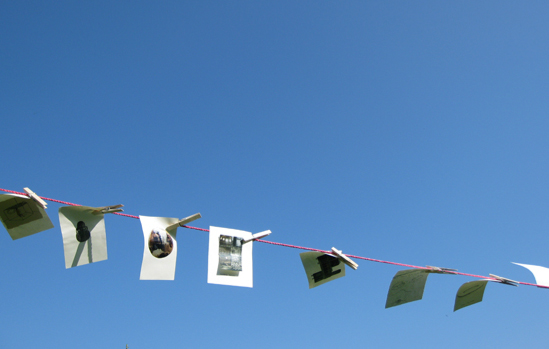Making a Washing Line Sketchbook
Making a Washing Line Sketchbook: A Creative Sketchbook Exercise By Paula Briggs

A washing line sketchbook is a great way to introduce children to some of the key ideas relating to working in a sketchbook. It’s a nice sociable event which gets children to actively experience some useful sketchbook skills. Because it is a physical activity, it encourages momentum and helps those children who otherwise might sit at a desk and become stuck in their thoughts. Getting older children to work with younger children, and involving teachers too, can really help the energy of the workshop.
Working in groups of 4 to 6 works best.
1) Collecting!
Build a washing line for your group – tie string across the classroom or work outside if you can. The line should be long enough to fasten 30 or so pieces of paper to it.
In this part of the workshop you’re going to need to collect! You’re going to collect words and pictures. Grab 10 or so sheets of paper and something to rest on. You’re going to explore an area (you teacher will tell you where). Work on your own (don’t follow your friend!) and we want you to look around really carefully. We want you to cover six sheets of paper with pictures, or words, or collages. Start by choosing something tiny and make a tiny picture. Then choose something a bit bigger, and make a picture, and carry on until you’ve made your six pictures and your last picture is of something much bigger. Use lots of materials – try different colours and media, and don’t forget you can cut and stick, and write words, as well as draw – you can do what ever you like. Your teacher won’t tell you what to do!
Back to the washing line – get yourself in a line and peg up your pictures – put all your pictures next to each other and leave small gaps between them. There should be no real no gaps between where your friends pictures stop and where your pictures start.
Stand back and admire your work!
2) Reflecting!
Reflecting means thinking about what you have done
Staying in line, get into twos or threes, and ask each other these questions:
Why did you choose to draw the things you drew? Why did you choose the materials you used? Why do you like or dislike them?
Note down your answers on a sheet of paper and peg them up next to your work.
3) Reacting!
Now its time to mess it up! Wander up and down the line till you’ve seen everyone’s work. Then forget all about which pictures are yours and which are your friends – pretend you all own them all, as a group.
Working together, rearrange the images. You might decide to rearrange images which share similar colours, or materials, or themes, or you might decide not to put things which are similar together, and instead to put images together which you think begin to tell a story. Any thing goes, as long as you’ve thought about it. Make sure you discuss and listen to all views – you can try things out by testing images next to each other. You might even decide to create extra images in response, or add certain words to the line.
This is real sketchbook thinking!
4) Reflecting again.
Stand back and enjoy the new order! How do you all feel?

5) Share.
Let the other groups enjoy your washing line sketchbook. What do they think? Can you talk to them about why you made it as you did?
When you are ready, take the pictures down, keeping the order as it is on the line, take a hole punch and make holes in the drawings, and lace them together to make group sketchbook.

